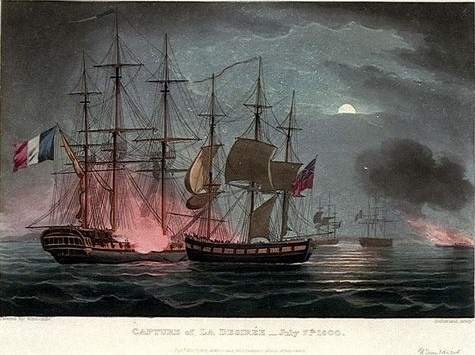HMS Dart was built in Redbridge, Hampshire, on the fringes of Southampton in 1796, and broken up in Barbados in 1809. She had the same bow and stern and could anchor from either end. She was so sharp in her construction that the midship section resembled a wedge. This resulted in poor stability, and she was unsafe in a wind. Hence her fairly short career as this version of the ship. There were later Royal Navy ships given the same name.

Around the end of August 1799, Dart captured the sloop Jonge Jan off the Dutch coast. Dart also shared with gunboats Defender, Cracker, and Hasty in the proceeds of the capture of the Hell Hound. Notices calling for claimants for the prize money were placed in the London Gazette on 7th January 1803. On 7 October 1799, the Dart, Defender, Cracker, and Hasty, and the schuyt Isis cut out four gunboats from their moorings in the Zuiderzee. Three of the gunboats were schuyts, [A schuyt is a flat-bottomed sailing boat used in the Netherlands, originally for fishing or carrying light cargoes. In the 17th century, they were rigged with two masts like a ketch, but by the 19th century, had adopted a single mast like a sloop] but one was a new, purpose-built gunboat armed with two 18-pounder guns in her bow and two 18-pounder carronades in her broadside. The three schuyts also carried four guns and carronades each. The vessels had crews ranging in size from 20 to 30 men. The British suffered no casualties [ Naval Chronicle, Vol. 3, p.141 ]. The behaviour of Messrs. Hall and Winter, midshipmen, were particularly commended. Rob Hall was also a midshipman on the Dart, and at least the City of Cork thought he deserved an award. He was twenty-one years old.
The following year Rob had been promoted, and had been gazetted a lieutenant on 14 June 1800. Less than a month later, HMS Dart took part in the Raid on Dunkirk, which was being blockaded by the British. The Channel ports were well suited for the French frigates that attacked shipping in British waters whenever they could escape the blockade.
HMS Dart, captured Désirée on 8 July 1800, in a night raid into Dunkirk harbour. Désirée was armed with 40 guns, those on the main deck being 24-pounder guns, and had a crew of 250 men under the command of Citizen Deplancy. However, a number of her crew were on shore. Dart lost one man killed and 13 wounded, including two officers badly wounded. Although several other vessels that participated in the raid had some wounded, Dart‘s capture of Désirée was the raid’s only real accomplishment. This capture resulted in Campbell’s promotion to post captain and command of the frigate Ariadne. French casualties were heavy. One account states that all the French officers, save a midshipman, were killed, and that casualties amounted to almost 100 men killed and wounded. Lloyd’s List reported on 11 July that the “Grand Desiree”, prize to the Dart, had arrived in the Downs, and that the French captain and about 50 men had been killed, and nine wounded. The French commander was capitaine de frégate Lefebvre de Plancy, and French records show that he was mortally wounded in the action.
The Royal Navy took Desiree into service, and many British vessels shared in the proceeds of the capture.In 1847 the Admiralty issued the Naval General Service Medal, with clasp “Capture of the Désirée” to all surviving claimants (only 21 surviving men) from the raid.[ Fonds Marine, p.235., and The London Gazette. 27 September 1800. p. 1123 ]
